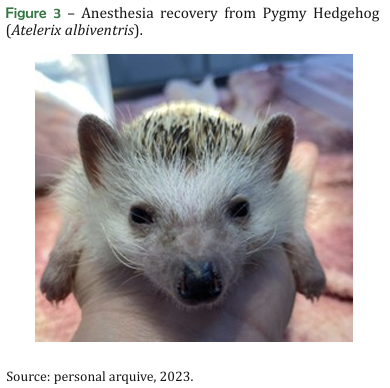Cardiopulmonary Cerebral Resuscitation in an African Pygmy Hedgehog (Atelerix albiventris): A Case Report
DOI:
https://doi.org/10.21708/avb.2025.19.1.12664Resumen
Exotic species are increasingly becoming a focus in veterinary medicine, necessitating proper handling by skilled professionals. Although the importance of staying updated on current practices is widely acknowledged, bibliographic references on such topics are often scarce. The African pygmy hedgehog (Atelerix albiventris), which has a life expectancy of 4–6 yr in captivity and an average weight of approximately 700 g, presents unique challenges to anesthetists due to its small size and high metabolic rate. This case report describes the successful management of cardiopulmonary cerebral resuscitation (CPCR) in a 6-year-old male African pygmy hedgehog weighing 430 g. The animal underwent a lumpectomy procedure. Physiological parameters remained stable during the first 10 min of the surgery; however, bradycardia, bradypnea, and hypothermia were subsequently observed. Isoflurane flow was reduced, but this was followed by the loss of electrocardiogram signals, pulse oximetry readings, and ocular reflexes, indicating cardiorespiratory arrest. The CPCR protocol was promptly initiated. Successful stabilization of physiological parameters in this case was achieved through careful management of the CPCR protocol, supported by knowledge of the species’ anatomy and physiology, effective anesthesia monitoring, and the rapid diagnosis of the arrest. This case highlights the importance of species-specific expertise in the successful management of critical incidents in exotic animals.
Descargas

Descargas
Publicado
Número
Sección
Licencia
Derechos de autor 2025 Acta Veterinaria Brasilica

Esta obra está bajo una licencia internacional Creative Commons Atribución 4.0.
Autores que publicam na Acta Veterinaria Brasilica concordam com os seguintes termos: a) Autores mantém os direitos autorais e concedem à revista o direito de primeira publicação, com o trabalho simultaneamente licenciado sob a Licença Creative Commons Attribution que permite o compartilhamento do trabalho com reconhecimento da autoria e publicação inicial nesta revista. b) Autores têm autorização para assumir contratos adicionais separadamente, para distribuição não-exclusiva da versão do trabalho publicada nesta revista (ex.: publicar em repositório institucional ou como capítulo de livro), com reconhecimento de autoria e publicação inicial nesta revista. c) Autores têm permissão e são estimulados a publicar e distribuir seu trabalho online (ex.: em repositórios institucionais ou na sua página pessoal) a qualquer ponto antes ou durante o processo editorial, já que isso pode gerar alterações produtivas, bem como aumentar o impacto e a citação do trabalho publicado (Veja O Efeito do Acesso Livre).


 Esta obra está licenciada com uma Licença
Esta obra está licenciada com uma Licença 